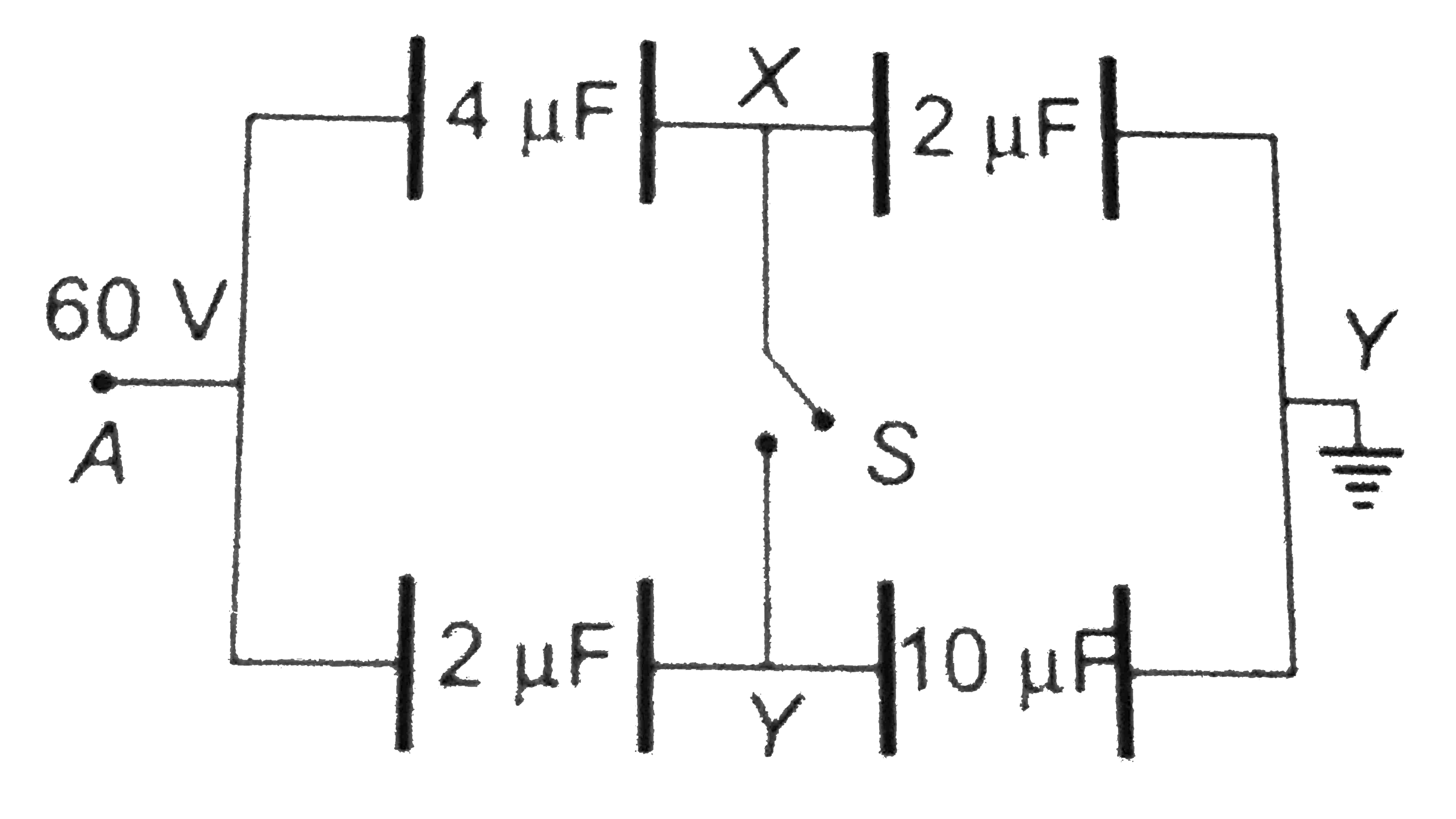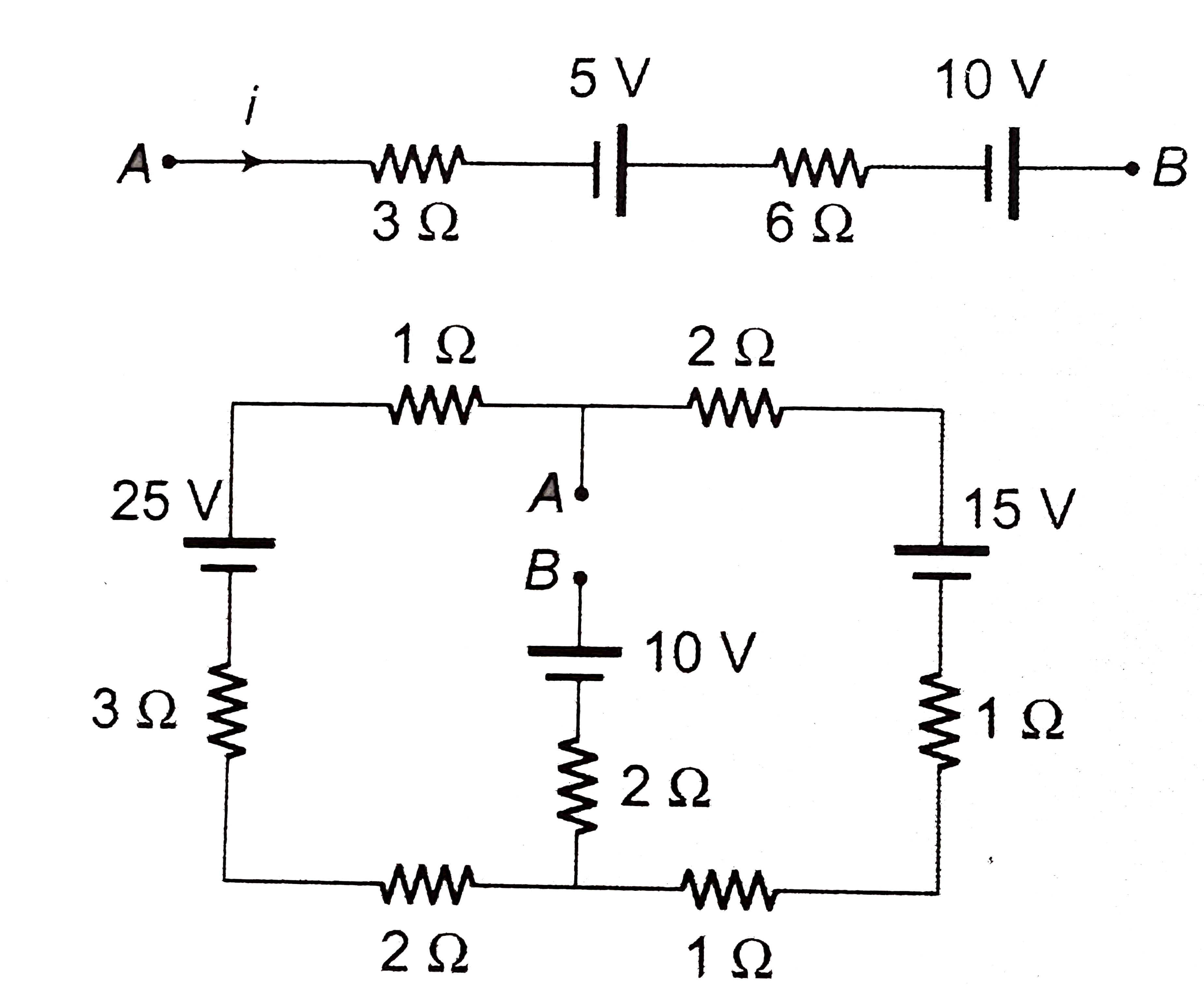Find :
(i) Potential difference between points M and N when switch 'S' is open.
(ii) Potential of point N after long time when switch is closed.
(iii) How much does the charge after long time when S is closed ?

(i) when S is open there is no current at steady state. Therefore
VM=18 volt
VN=0 volt
⇒VM−VN=18 volt
(ii) When 'S' is closed, after long time steady state reaches and current through resistor
I=186+3A
VA−VM=6×2 volt
VN−VB=3×2 volt
∴VB=0 volt ∴VN=6volt

(iii) When switch S is open charge on each capacitor is due to same potential difference 18 volt.
q1=18×6μC
=108μC
q2=18×3μC =54μC
When S is closed at steady state charge on each capacitor becomes.

q′1=12×6μC=72μC
q′2=6×3μC=18μC
Δq1=(72−108)=−36μC
Δq(2)=(18−54)=−36μC

Topper's Solved these Questions
- BOOK - AAKASH INSTITUTECHAPTER - CURRENT ELECTRICITYEXERCISE - Try Yourself32videos
CURRENT ELECTRICITY
- BOOK - AAKASH INSTITUTECHAPTER - CURRENT ELECTRICITYEXERCISE - ASSIGNMENT(SECTION-A(OBJECTIVE TYPE QUESTIONS))59videos
CURRENT ELECTRICITY
- BOOK - AAKASH INSTITUTECHAPTER - COMMUNICATION SYSTEMS EXERCISE - ASSIGNMENT SECTION D (Assertion-Reason)10videos
COMMUNICATION SYSTEMS
- BOOK - AAKASH INSTITUTECHAPTER - DUAL NATURE OF RADIATION AND MATTER EXERCISE - ASSIGNMENT (SECTION-D)10videos
DUAL NATURE OF RADIATION AND MATTER
Similar Questions
Find :
(i) Potential difference between points M and N when switch 'S' is open.
(ii) Potential of point N after long time when switch is closed.
(iii) How much does the charge after long time when S is closed ?
 View Solution
View Solution(a) Taking the potential at the point B to be zero, find the potential of point D.
(b) Find VA−VB. Under what condition is it equal to zero.
(c) Consider the situation as shown in diagram. How much charge will flow through cell if the switch S is closed?
(d) In the circuit shown in the figure, calculate
(i) Potential difference between the points X and Y.
(ii) Potential of the point X when switch S is closed.
(iii) Charge flown through the switch when it was closed.



 View Solution
View Solution
Knowledge Check
- Question 1 - Select One
Find the charge flown when the switch S is closed.
 AzeroBε0AdVC32ε0AdVDε0A2dV
AzeroBε0AdVC32ε0AdVDε0A2dV - Question 2 - Select One

In the circuit shown above, when then switch S is closed,Ano charge flows through SBcharge flows from A to BCcharge flows from B to ADcharge flows initially from A to B and later from B to A - Question 3 - Select One
Consider the situation shown in figure (31-E23 ) . The switch S is open for a long time and then closed . (a) Find the charge flown through the battery when the switch S is closed (b)Find the done by the battery .
 AC∈/2BC∈/4CC∈Dnone of these
AC∈/2BC∈/4CC∈Dnone of these

(a) What is the potential of point a with respect to point b in figure, when switch S is open?
(b) Which point, a or b, is at the higher potential?
(c) What is the final potential of point b with respect to ground when switch S is closed?
(d) How much charge flows through switch S when it is closed?View Solution(a) Find the potential difference between A and B

(b) A circuit has a section AB as shown. If VA−VB=12V, find current i.

( c) (i) Find the potential difference between the points A and B
(ii) Find current through 25V cell if points A and B are connected.

(d) In the following circuit, calculate
(i) Potential difference between points X and Y, when switch S is open.
(ii) Current through switch S, when switch S is closed.
(iii) Equivalent resistance between A and B. .View SolutionFind the charge which flows from point A to B, when switch is closed
 View Solution
View SolutionFind the equivalent resistance of the network shown in figure between the points a and b when (a) the switch S is open and (b) the switch S is closed .
 View Solution
View Solution
(a) What is the potential of point a with respect to point b in figure, when switch S is open?
(b) Which point, a or b, is at the higher potential?
(c) What is the final potential of point b with respect to ground when switch S is closed?
(d) How much charge flows through switch S when it is closed?View Solution

